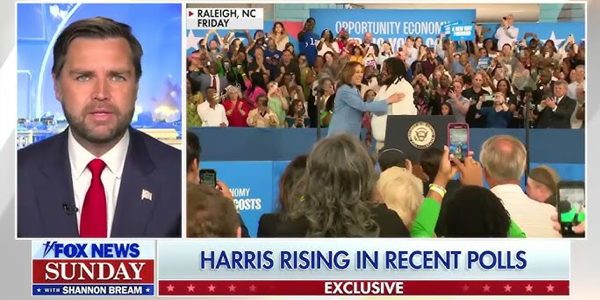
Does the Media Use Fake Polls to Depress Republican Turnout?
Written by Elizabeth Vaughn
Ahead of the Democratic National Convention this week, “Fox News Sunday” host Shannon Bream rattled off the latest batch of battleground state polls from New York Times/Siena College to U.S. Senator J.D. Vance (R-OH), which showed Vice President Kamala Harris leading former President Donald Trump by 5 points in Arizona and by 2 points in North Carolina. She also referenced two new national surveys from ABC News/Washington Post and CBS News showing Harris ahead of Trump by 4 points and 3 points in those respective states.
Asked for a comment, Vance replied, “Consistently, what you’ve seen in 2016 and 2020 is that the media uses fake polls to drive down Republican turnout and to create dissension and conflict with Republican voters. I’m telling you, every single person who’s watching this, the Trump campaign is in a very, very good spot. We’re going to win this race. We just have to run through the finish line.”
WATCH: @JDVance on recent polls as the 2024 presidential race remains tight. pic.twitter.com/nXUDEPt3w2
— Fox News Sunday (@FoxNewsSunday) August 18, 2024
So, is Vance right, or is he in deep denial? Is Harris’s ostensible momentum real or manufactured?
There are indications that Vance may be on to something.
I question the accuracy of the New York Times/Siena College polls because Republican pollster Rasmussen, a polling company that is well-known for its accuracy, released very different numbers the previous day. Nationally, Trump led Harris by 4 points, according to Rasmussen. Among independent voters, he was ahead by 9 points.
Someone apparently has an eye for consistently accurate polling pic.twitter.com/LUCkxkpb42
— Rasmussen Reports (@Rasmussen_Poll) August 16, 2024
Moreover, on Friday, polling guru Nate Silver published an article about the Times’ latest results titled, “Is it possible our polls have been underestimating Trump? Yes.”
Silver began by addressing an internal memo written by the Trump campaign’s chief pollster, Tony Fabrizio, about the Times’ latest polls, which he claimed “ha[d] dramatically understated President Trump’s support both among all registered voters and in their likely-voter model.”
Fabrizio argued, “In each state, the gap between the survey’s recalled 2020 vote and the reported 2020 election results is more than the margin” between Harris and Trump. “Once again, we see a series of public surveys released with the clear intent and purpose of depressing support for President Trump,” Fabrizio added.
In a “recalled vote” poll, respondents are first asked to “recall” which candidate they voted for in 2020, and then asked whom they plan to support in November. For example, Silver explains, “In the polls of Pennsylvania, Michigan, and Wisconsin, respondents recalled backing President Biden over Mr. Trump by six points, 52% to 46%, even though Mr. Biden actually won these three states by an average of about 1.5 points. The Trump campaign used this data point to say Mr. Trump would have led if the poll had the ‘right’ number of Trump 2020 supporters.”
Silver admits that “over the longer run, recalled vote hasn’t usually been very reliable.” He takes readers through a detailed – and confusing – discussion of occasions when the use of recalled vote produced accurate polling results vs. the times it did not.
Silver added that sometimes voters forget who they voted for four years earlier, or they want to say they backed the winner, which was Biden.
Here’s a third possibility: Maybe the New York Times oversampled Democrats.
Silver ultimately concludes: “No one ever knows which polls — or which polling methodologies — will appear ‘right’ or ‘wrong’ until the election.”
While that’s true, we’ve seen some pretty surprising polling data this cycle. Perhaps the most alarming result so far was a Bloomberg/Morning Consult poll released late last month that showed Harris ahead of Trump in Michigan by 11 points. Two surveys of the state had been released the previous day. The first, from Fox News, showed the race tied. The second, from The Hill/Emerson, found Trump ahead of Harris by 1 point. If we extract the Bloomberg/Morning Consult poll from the RealClearPolitics average of Michigan polls, Harris’s current 2-point lead in the state would fall to 0.9 points.
Another shocking result in recent memory was a Washington Post/ABC News poll released days before the 2020 election that found Biden leading Trump by 17 points in Wisconsin. Although Biden won the state, the final margin was 0.6 points.
At any rate, as the Democratic National Convention kicks off, Harris’s numbers have been starting to flatten (meaning the increases were becoming smaller and occurring more slowly), signaling that her “honeymoon” phase may be coming to an end.
Still, she is likely to receive a convention bounce which, historically, have ranged in size from -1%, as John Kerry and Mitt Romney experienced in 2004 and 2012, respectively, to former President Bill Clinton’s spectacular 16% surge in 1992.
So, is Vance right? As Silver said, no one will know until Election Day. But given the drastic lengths to which Democrats already have gone to keep Trump out of the White House — the 2016 Russian collusion hoax, two Trump impeachments, the October 2020 letter signed by 51 former intelligence community officials declaring the Hunter Biden laptop story had all the hallmarks of a Russian disinformation campaign, the government’s insistence that the COVID-19 lab leak theory was a conspiracy, four bogus Trump indictments, two spurious civil lawsuits in New York, concerted efforts to remove Trump’s name from the ballot in several blue states, and the Democrats’ extraordinary efforts to hide Biden’s deteriorating cognitive health — can the Left ever really be trusted?
This article was originally published at American Free News Network.
Elizabeth Vaughn is a conservative political blogger and mom of three residing in southern Connecticut. Following a career in the financial services industry, she has been a regular contributor to conservative websites.













